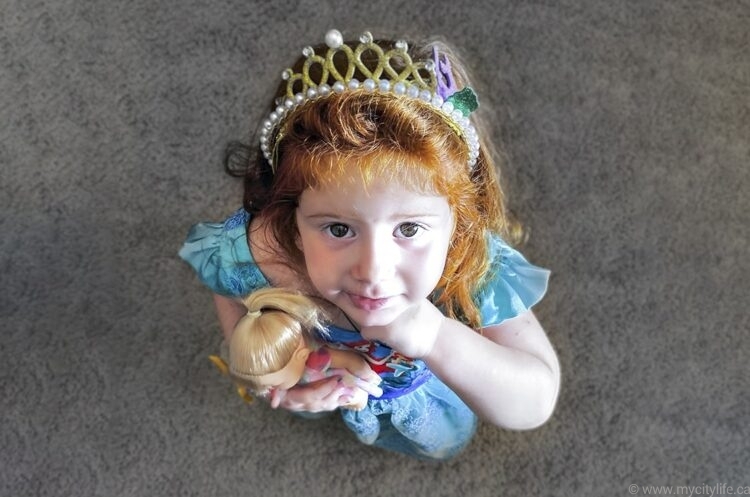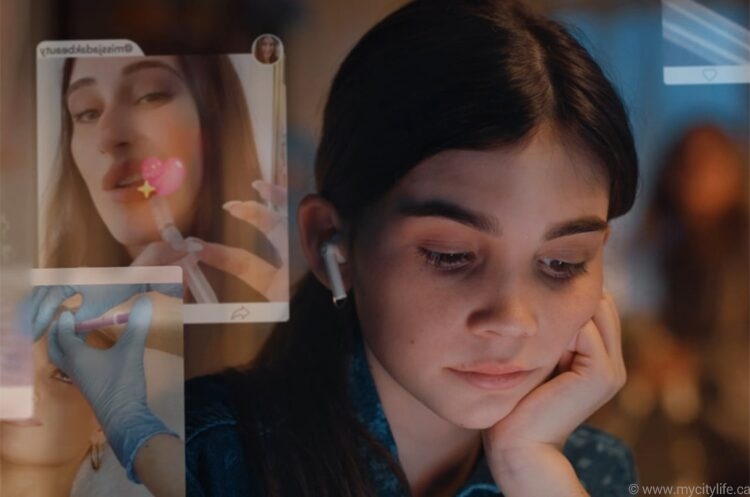Inspiring Young Girls Becoming On Their Journey To Empowered Women
Social media platforms, such as TikTok and YouTube, have dramatically changed — especially for young girls— the fundamental experience around growing up. Self-esteem and confidence is measured by conforming to false norms that are both unrealistic — and, at times, toxic.
Youth — those fledging years of self-awareness that are beginning earlier and earlier in this interactive society and now represent an age group that begins anywhere from 11 or 12 — is often referred to as the state of being one of the best times of our lives a carefree time with no responsibilities or worries about money or what we want to be when we grow up or how we’re going to get from here to there as we navigate through all of life’s encumbrances. At the risk of being labelled an old-school fuddy-duddy, I remember what it was like when I and many of our current City Life readers were young: Our lives were robustly full of family activities and face-to-face after-school gatherings with our friends and the kids on our block.
Sure, we saw those larger-than-life model-type images plastered on billboards, the sizzling promises of a “better you” on our television screens, the full-colour ads in our newspapers and the 5-foot-tall point-of-purchase promotion boards in our local shops, but none of those things were ever on the scale of today’s ubiquitous messaging platforms. In fact, a 2021 survey conducted by PPC Protect (ppcprotect.com) estimated that the average person today sees 6,000 to 10,000 ads per day, compared to the 1970s, when the average number of ads seen per day was anywhere from 500 to 1,600.
Online platforms provide significant opportunities for advertisers and marketers to get their messages out to young people. In fact, a November 2021 Forrester Research survey reported that 63 percent of Americans between the ages of 12 and 17 used TikTok on a weekly basis, while 57 per cent of this cohort was on Instagram.
In Canada, according to an August 2021 Media Technology Monitor MTM Junior research study that polled 1,622 households, 74 per cent of Canadian kids aged seven to 17 had used social media in the last month, with girls more likely to use it than boys (80 per cent versus 68 per cent). That number dipped to 58 per cent for kids from seven to only 11, who are more likely to have content and time controls on their social media platforms.
With the widespread adoption of social media platforms, especially the highly popular TikTok, Instagram and YouTube channels, the critical issue for young girls becomes the lack of age-appropriate products and same-age role models, which in turn influences these vulnerable young people to adopt and emulate behaviours that are inappropriate for their age groups.
This is not to say that, before this explosion of social media usage within today’s youth cohort whose online and phone interactions have become ubiquitous and often obsessive, there weren’t examples of high-profile early celebrity influencers, some of whom imploded. We don’t have to look far to find role models that young girls used to look up to — in fact, couldn’t get enough of — before their public personas went drastically wrong. Remember when Justin “the Biebs” Bieber egged his neighbour’s house in Los Angeles in 2014? Or the very public flameout of the Disney teeny-bopper idol, Miley Cyrus, of Hannah Montana fame? News about both of these outsized personalities as they spiralled, crashed and burned were splayed across every newspaper and blasted from every radio station, television channel and social media platform in existence at that time.
Now, however, the problem is that, while many of the issues that young girls are facing today are similar to those faced by this age group in previous generations, the overwhelming omnipresence of social media has ratcheted up their levels of influence and reach to never-before-seen heights.
Of deep concern to parents, teachers and guardians is the impact and influence that social media have on young people, young girls in particular. In both subliminal and overt ways, they are being taught harmful attitudes and behaviours, ones that illustrate that the body shapes that they must aspire to and need to achieve to look good, fit in and be part of the crowd must reflect the unrealistic posts they are seeing. These “adopter” images portray thin, shapely bodies, age-inappropriate and sexualized outfits and behaviour that should be well beyond the knowledge or comprehension of children and young teens.
The celebrity images and seemingly real lifestyles posted on sites, such as Instagram and Pinterest, are façades, undeniably Photoshopped to remove blemishes, extra curves and any number of other minor flaws unacceptable to “influencers.” How can a young girl not be impressed by these seemingly flawless images and wonder what’s wrong with herself? Why is her body so different from the images that she sees? After all, with all the thousands of “likes” she sees these posts getting, this is the “look” that must be the ticket to being accepted and loved.
Interestingly, in an October 6, 2021, CBC news article by Mark Gollom (cbc.ca), he relates the findings reported in the Wall Street Journal of a study conducted by Facebook, the owner of Instagram, conducted to ascertain how Instagram affects its millions of young users. “Instagram can be harmful for a significant number of users, in particular teenage girls,” it openly admitted. About a third of teen girls in the survey said that when they felt bad about their bodies, Instagram made them feel even worse. The research also showed that the peer pressure the image-focused Instagram generated led in some cases to eating disorders and to thoughts of suicide.
In fact, a story related to me by a Toronto Grade 6 teacher resonates deeply. Many of the girls in her class, who are 11 years old, can be easily mistaken for 14 to 16. “The physical mirroring around what these girls see on social media, such as heavy makeup and revealing clothing, makes them appear much older than they are, which is highly concerning,” she said. “They are young, vulnerable and naïve, and easily susceptible to older male attention.”
Dr. Niva Piran, a clinical psychologist, award-winning author, researcher and professor emerita at the University of Toronto, whose 2017 book Journeys of Embodiment at the Intersection of Body and Culture (London: Academic Press) examines the social experiences that shape girls through their development and into adulthood, states that it is important to understand the current struggles of girls.
“Girls now live in a contradictory world,” says Dr. Piran. “On the one hand, they are told that all options are open to them — that they can attain any and all positions if they work hard and get their education. That is one type of message, that equal participation in society is available to them. At the same time, at the physical level, they are exposed to very different messages.”
She goes on to explain that the rates of violence against women, gender gaps in pay and access to reproductive health services, for example, have remained problematic areas for women. Girls at puberty are aware of and can describe such challenges faced by women in their lives. She goes on to state that living in a world of contradictory messages is very difficult for young girls.
“It is common and acceptable for young girls to try and change their bodies in order to become more accepted,” Dr. Piran says. “Social media transmits images that have a negative impact on our youth — messages that convey that the bodies of girls at puberty are inherently deficient and require repair — in weight, breast enhancement, hair straightening, lip expansion or skin whitening. As such, the focus of these young girls changes from one of acting on the world to one of acting on their bodies, which in turn makes them lose power. And from that point onward, no body repair is good enough — the body remains deficient, and it is challenging to get out of that mindset. Secondly, it is really hard to act in the world with power and agency when you experience your body as a deficient site, because, at the end of the day, we interact with the environment through our bodies.”
Catherine Steiner-Adair, clinical psychologist, consultant and co-author with Teresa Barker of The Big Disconnect: Protecting Childhood and Family Relationships in the Digital Age (a Wall Street Journal Best Nonfiction Book in 2013), also identifies some of the critical issues facing young girls today.
“There is a backlash of misogyny against both young girls and women who come from predominant cultures,” Steiner-Adair says. “The message out there is that what you look like matters more than anything else. Also, there is the endless appearance of unrealistic beauty images that promote dieting and shopping as reasonable ways to cope with life’s ups and downs.”
Many social media platforms, particularly Instagram, where celebrities of every ilk are known to post the minutiae of their lives, strongly influence the mindsets and behaviours of vulnerable young girls who just want to fit in.
“These types of messages direct girls to body dysmorphia, disordered eating and eating disorders,” Steiner-Adair states. (Not all disordered eaters develop into full-blown eating disorders.) “And while it is hard to identify causation, the correlation to body dissatisfaction and eating disorders, such as anorexia, is strong.”
In fact, in a March 18, 2021, CBC news report by Desmond Brown, a spokesperson for McMaster Children’s Hospital stated that referrals to the hospital’s Eating Disorders Program had increased by 90 per cent in the last four-month period. As well, youth admitted for medical support after a suicide attempt had tripled over the same period, compared to the previous year. (cbc.ca).
Red flags for young girls and their parents, who should both be aware of and recognize toxic social-media messaging, include the suggestions that a particular appearance is desirable, beautiful and necessary, and in fact, is what girls should strive to emulate. The posts and popular music-based videos that appear as beauty advice on social media include content that portrays unrealistic ideals of beauty that girls say make them feel bad about themselves, and in fact, sets standards that no girl can reasonably live up to.
A key concern identified both by Dr. Piran and Dr. Steiner-Adair was the ongoing and seemingly growing number of acts of sexual violence targeting girls under the age of 18.
“Sex education is not doing enough to inform young people about sexual negotiations. Girls are vulnerable to violations — and are not knowledgeable about sexual encounters. The highest rape incidence in the United States — reported at 7.7 per cent — happens to girls who are under 18,” says Dr. Piran.
Dr. Steiner-Adair concurs. “Increased sexual violence toward girls is impacting the younger age groups, and I think that some cultures’ acceptance of violence against women has increased. It is very dangerous. If women don’t have the right to control their own bodies, a highly controversial issue that is embedded in the abortion issue in the United States, it is no longer a women’s issue, it is a human rights one. It is important for the media to feature women on their covers who don’t look like they are hired models — but rather, real women, who are healthy and happy in their own bodies.”
The Dove Self-Esteem Project, which aims to confront the harmful beauty advice often normalized for teens in their social media feeds, is committed to helping parents navigate important conversations with their kids. In an email Q & A with the team at City Life Magazine, Dove summarized the findings of their 2022 Self-Esteem Project survey, which was conducted on girls age 10 to 17 in Canada as a way to understand this group’s social media habits and attitudes they are influenced to adopt as a result of their social media involvements.
The research reveals that, in general, young girls are spending more time on social media than ever before — connecting with friends, finding new communities and engaging with an endless stream of content and advice in their feeds, with one in two girls saying idealized beauty advice on social media caused their low self-esteem. Facing this toxicity head-on, the new Dove #DetoxYourFeed campaign aims to counter the harmful beauty advice being normalized for teens in their social media feeds by providing tools to help parents navigate important conversations with their teens, resources to empower teens to define their own beauty standards and encourage them to unfollow content that makes them feel bad about themselves. In fact, research found that seven in ten girls have felt better after unfollowing toxic beauty advice and idealized beauty content on social media.
Parents should take note that the Dove research showed that half the surveyed girls spend more than an hour each weekday on social media, more time than they spend with friends outside of school. The majority of girls surveyed (67 per cent) say it would be better for their self-esteem if young girls in general spent less time on social media and that it would be better for their own self-esteem if they themselves spent less time on social media. But the girls also stated that they use social media as a way to express themselves, to share their thoughts (26 per cent) and to express their identity (20 per cent).
So, what can parents do to protect their daughters from falling prey to completely unrealistic “influencers,” whose looks and “desirable” lifestyles drive their daughters’ all-encompassing interest?
For starters, parents need to be present, available and nurturing to their kids, as well as highly aware of the sites their young people are visiting and the amount of time they are spending on them. Parents need to advocate for policies that empower their children and closely watch not only their child’s online activity but the appropriateness of the people they are interacting with.
“It Is Important To Nurture Social Participation In Equal-partner Groups, Ones That Are Made Up Of Peers Who Validate And Nurture Each Other’s Strengths While Empowering Relationships”
It is important that adults in young girls’ lives are supportive, offering guidance, mentoring and an always-present “listening” ear. It is also critical to discuss and help this age group, who are from around 11 years old, become attuned to their needs and be knowledgeable about what healthy development looks like.
“For instance, weight gain during puberty is a healthy and natural process,” Dr. Piran says, but “girls do not learn that. Girls learn to look at weight gain during puberty as a dangerous thing rather than a healthy thing. [But] weight gain is also important for the secretion of growth hormones and other hormones and for the strengthening of bones during this critical age. This is important information that they should learn.”
In fact, in her clinical psychology practice, Dr. Piran has observed girls who have experienced stunted growth because their parents, and sometimes their physicians, put them on a diet at this critical age and stage of development.
Interestingly, she notes that when girls are going through puberty and begin menstruating, they have to learn what is acceptable within the setting of their own peer groups. “They learn that they need to be small and demure rather than powerful. If girls show their competitive side, they are considered to be a bitch,” she says. “Young girls learn that people don’t want women to be in control, even in the political arena, so the strong voice that they had before puberty becomes silenced in their quest to be deemed acceptable. We need to nurture girls to be powerful and to respect their strong voices. This will also help protect them from negative media, because social media doesn’t like young girls to be comfortable within themselves — they want them to be self-critical so they can shut them down. Girls often experience a demotion in their social power when they reach puberty because their body becomes more important than their voice. It is very important that young girls have social power unrelated to their appearances. Lastly, it is important to nurture social participation in equal-partner groups, ones that are made up of peers who validate and nurture each other’s strength while empowering relationships.”
“There Are A Lot Of Phenomenal Girls In The World,” Says Dr. Steiner-adair. “we Are Just Not Hearing Enough About Them”
There are myriad resources available for parents who want to engage with and actively help their daughters invest in their own personal empowerment. While rife with negative influences, the Internet can also be an asset, with many positive and affirming websites that reach out to girls around the world to inspire and empower them.
Sites such as www.sparkmovement.org, an informative and positive online resource recommended by Dr. Piran, is, according to its website, a “girl-fueled, intergenerational activist organization working to ignite and foster an antiracist gender justice movement” to end violence against women and girls and promote girls’ healthy sexuality, self-empowerment and well-being. For younger girls, the sheheroes.com website profiles apps that embrace key themes, such as championing a passion for learning, being curious and observing the world, appreciating the uniqueness of each person, identifying and celebrating personal strengths; speaking out and being assertive when peers are being picked on, criticized or bullied; being adventurous and bold, trying new things and not giving up when things are hard are also highlighted.
Even the toy-maker Mattel has realized that it has to be cognizant of how its idealistic version of toys impacts their young customers and have introduced, along with the original prototype, a new and more physically realistic line of Barbie dolls that features petite, tall and curvy models.
If parents want to increase their social-media knowledge and ensure that their teen daughters’ online interactions are safe, they can check out Dove’s Detox Your Feed: The Parents Guide, a three-minute educational film that has advice for parents, caregivers and mentors on initiating conversations with young people about the harms of social media. Dove also offers The Confidence Kit, a free Self-Esteem Project workbook that includes tools to facilitate conversations with your kids about toxic social media advice.
Parents can also help their children decide if the content they follow is right for them by suggesting that they engage in Dove’s #DetoxYourFeed themselves. Easy steps to follow for a more positive and reaffirming online experience include simply encouraging girls to follow content or people that are positive and uplifting and to unfollow toxic content that does not improve their mood or sense of well-being. Teens themselves should be aware of the content that they post and to think about and make sure they understand the impact their own content will have on others.
It is important for adults to be supportive and offer guidance, mentoring and a listening, “present” ear, on an ongoing basis, to their young children, especially their girls. It is also important to discuss with them how to be attuned to their own needs and provide them with information about healthy eating for their optimal development.
“We need to focus on fostering resilience and protecting our youth,” Dr. Piran says. “Considering the targeting of girls’ appearance by social media, it can be valuable, instead, to nurture other physical experiences among girls, in particular, those of functionality and joy in the body. Joyful engagement in physical activities that do not objectify the body can be an important protective factor. It is valuable to continue such engagement during and following puberty.”
It is also their parents’ responsibility — moms in particular — to not pass down messages of body-loathing and negative body criticisms. “Mom has to stop saying, ‘Oh, my thighs and my butt are too big’ or ‘My hair is too thin’ — these kinds of self-criticisms can lead to negative self-esteem,” Dr. Steiner-Adair says. “Also, men have to feel comfortable encouraging their daughters to feel good in their natural bodies — in fact, they should take a feminist position against anorexic-shaped models. Fathers and male role models should help girls feel that they matter for exactly who they are.”
Helping young girls navigate through the mire of ubiquitous influencer messages — ones that “inform” but actually direct in order to manipulate and sell the latest products — is a responsibility that lies with each one of us. It is imperative that the next generation be equipped with a sense of self-worth, self-esteem, confidence and purpose — attributes that will mature and empower them to become the women that they deserve and are entitled to be.
If they are to emerge from their teen years as strong, happy and confident young women, girls must learn to identify the pitfalls of peer pressure and the negative criticisms around body image. Positive life decisions start early in life and are the ultimate gateway to empowerment for women. Early influences have the potential to either lift up or negatively impact our children’s ability to appreciate who they are and how they look. Our goal as parents and mentors should be to empower our girls so that, ultimately, they can achieve the goal of becoming powerful, self-directed agents within society at large.
It is a fact that young girls who are absorbing the predominant social-media messages, are susceptible to philosophies such as, “I have an eating disorder” and are liable to adopt them to be accepted.
“Girls describe the power they derive from being accepted without pressures of conformity in terms of their appearance or behaviour. Such a validating environment is important within families, among peers and other social systems, such as schools,” says Dr. Piran. “Becoming accepted starts with the social groups young girls hang around with. They are vulnerable to peer pressure and opinions, and, so, with the right reinforcement and acceptance, they can accept themselves on life’s terms.”
Boards of education can also get more proactive in supporting young girls in the school system. Implementing policies that address sexual harassment, body-based harassment and bullying (such as teasing or comments about weight, for example), with clear consequences for infractions, certainly represents a positive step forward. Ensuring that boys and girls have equal access to physical and sports activities and resources is also important and achievable within the school environment.
“There are a lot of phenomenal girls in the world,” says Dr. Steiner- Adair. “We are just not hearing enough about them.”
BARBIE’S EFFECT
The effect of playing with this unrealistically thin and busty doll on girls’ self esteem.
In a world where the majority of people — specifically, its women — are constantly criticizing our own bodies, our weight, and, indeed, anything else at all about our physical being in the world — at some point the poignant question “Why?” needs to be asked.
Why do women demand so much of ourselves and attach such importance to the arbitrary standards set by fashion houses and leading beauty brands?
Have you seen some of the tag lines attached to those high-gloss full-colour magazine ads? If they weren’t so meaningless they would be bizarre. What exactly does “Beauty is a gesture” even mean? Or “The scent of all paradoxes”? One telling example of how we as a society came to adopt one of the most unrealistic ideals of what we, as women, are expected to aspire to is outlined at study.com by mental health counselor Gaines Arnold.
In 1959, while on a trip to Germany, American Ruth Handler noticed that the popular “Lilli Doll” possessed adult female features specifically designed to appeal to men. Handler had observed that her daughter, Barbie liked to play with paper dolls that looked like adult women, rather than enjoying traditional baby dolls, and had an idea about how these more adult-like dolls — modelled for male sexual interests — could be adapted for children. First forming the Mattel Corporation with her husband and then partnering with Disney, Handler began marketing her Barbie dolls to young girls.
While there is no denying that these dolls were wildly popular with girls, they always conveyed a subliminal message — to be popular a girl needed to have perfect blonde hair, a killer body, good looks and, effectively, no career. All Barbie had to do in her perfect Barbie world was to dress up and wait for Ken to bring home the proverbial bacon.
Over the decades since Barbie’s creation, this idealized — and, some would say, harmful — fashion icon has inspired psychologists to study what is known as the “Barbie Effect.”
It boils down to this: media messaging over the last seventy years has dramatically changed the definition of an attractive, desirable woman.
In the 1600s, double chins and fuller figures whetted men’s lust. Inn the mid-1800s, men also liked their women plump. Beginning in the 1960s, though, with the introduction of supermodels like Twiggy, men’s fascination turned to women who were toned, willowy and fit — pretty much a mirror likeness of the Barbies that impressionable little girls aspire to be in their imaginary, idealized worlds.
Writer Samantha Olson reports in an article in the online Medical Daily, “According to doctors, Barbie’s measurements would force her to walk on all fours. She would be physically incapable of lifting her over-sized Mattel head. She could be nicknamed the ‘impossible woman’ with unrealistic physical proportions that would make her look like she’s straight off a spaceship.” medicaldaily.com
In fact, Barbie’s idealized “perfect” head-to-toe proportions have caused eating and body disorders in young girls who aspire to look like her. There isn’t any clear messaging around Barbie engaging in or preparing for a career, either, which — although hopefully not in this increasingly women- empowering world — might lead a young girl to believe that all she has to do to succeed in life is to look pretty.
Mattel has addressed some of these issues in recent years, producing dolls that feature more diverse and truer-to-life looks and body shapes. For mirroring that effects acceptance for all ages is key to actualizing girls’ “self-acceptance persona.”



















































































